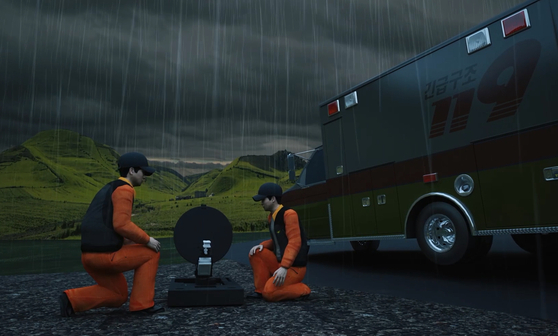Researchers in Korea have developed a technology that supports communication in a situation where a mobile phone is a’meat’. It is a technology that is highly likely to be used in disaster sites or military and police communication networks due to the small size of the core component chip and low cost.
ETRI succeeds in developing satellite communication modem chip
Width and length 1.3 cm 50 won coin size
Network type satellite communication access technology
Possible to respond at the fire and earthquake site
The Electronics and Telecommunications Research Institute (ETRI) announced on the 9th that “We have developed a satellite communication modem chip (ASIC) that can communicate throughout the mountainous regions of Korea.”
![The situation where satellite communication is possible even at the disaster site is composed of a virtual computer graphic. 119 rescuers are attempting satellite communications to locate isolated people in islands and mountainous areas. [사진 ETRI]](https://i0.wp.com/pds.joins.com/news/component/htmlphoto_mmdata/202102/09/4c1939c0-a1c7-431a-a915-5976ad1f14ce.jpg?w=560&ssl=1)
The situation where satellite communication is possible even at the disaster site is composed of a virtual computer graphic. 119 rescuers are attempting satellite communications to locate isolated people in islands and mountainous areas. [사진 ETRI]
Current mobile communication technology is based on a base station. However, it cannot be used if there are geographical restrictions, such as some islands and mountainous areas, or if the telephone office cannot function properly due to fire or earthquake.
In contrast, satellite communication is free from such restrictions as satellites floating in space act as relay stations. However, satellite communication has two disadvantages. Once the voice is transmitted through the sender → satellite → repeater (hub) → satellite → receiver, there is a time delay. It means that the phone sounds one beat late.
Another problem is that it requires a lot of auxiliary equipment. The weight of auxiliary equipment such as antennas and base stations that exchange signals with satellites is around 100kg. It is difficult to carry around unless transported by vehicle.
![In-ki Lee, senior researcher at ETRI, is checking the antenna for small satellite relay equipment. It is a technology that enables satellite communication even in a telecommunication disaster situation. [사진 ETRI]](https://i0.wp.com/pds.joins.com/news/component/htmlphoto_mmdata/202102/09/c1aea937-4a67-4f38-97ca-25259985acff.jpg?w=560&ssl=1)
In-ki Lee, senior researcher at ETRI, is checking the antenna for small satellite relay equipment. It is a technology that enables satellite communication even in a telecommunication disaster situation. [사진 ETRI]
To solve this problem, ETRI applied a mesh topology type satellite communication access technology. This connection technology has a short delay because the signal is transmitted through the sender→satellite→receiver without going through a repeater.
However, the network type satellite communication access technology requires a separate reception device to hear the voice of the other party. ETRI solved this problem by developing a modem chip (ASIC/ASIC) that combines the receiver and transmitter into one.
![Satellite communication chip developed by ETRI researchers. [사진 ETRI]](https://i0.wp.com/pds.joins.com/news/component/htmlphoto_mmdata/202102/09/4a7385ac-b2a8-4b2c-82e3-3f942f2b5071.jpg?w=560&ssl=1)
Satellite communication chip developed by ETRI researchers. [사진 ETRI]
The modem chip developed by ETRI is 1.3cm in width and length respectively. It’s only a 50 won coin. One such small chip reduced the size of satellite communication auxiliary equipment and reduced communication delay (0.5→025 seconds). If you use this chip like a base station, you can use a mobile phone even in a situation in which mobile communication is ‘muck’. Up to 32 channels and different signals can be sent and received at the same time, and the transmission rate (13Mps) is the level that can even stream video.
The satellite communication technology developed by the ETRI research team completed the verification test by communicating with the Cheonrian satellite. In the future, it will be put into the disaster and disaster sites through a verification process with the Ministry of Public Administration and Security, the Maritime Police Agency, and the Fire Protection Agency.
Lee In-ki, a senior researcher at ETRI’s Satellite Wide Area Infrastructure Lab, explained, “It is a technology that can reliably communicate in a disaster situation, bridge the information gap in remote islands and mountains, or support military communication in military operation areas.”
Reporter Moon Hee-cheol [email protected]
